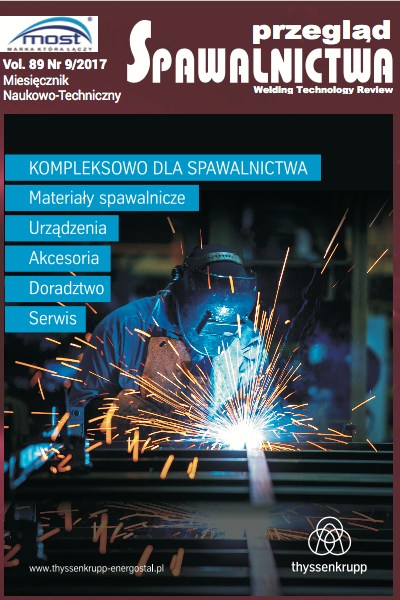Resistance of welded joints 304 and 304H to intercrystalline corrosion
Main Article Content
Abstract
Austenitic steels belong to the group of materials with high application potential in the power industry. Due to the high working temperature and corrosive environment, it is necessary to determine the resistance to intercrystalline corrosion of austenitic steels. The paper presents the results of intergranular corrosion resistance test of TIG welded joints made of 304 and 304H steels. The studies were carried out in a solution of 40% sulfuric acid (VI) and iron (III) sulfate, and then the samples were bent in accordance to the requirements of PN-EN ISO 3651-2. The study has demonstrated that steels with austenitic structure are characterized by good resistance to intergranular corrosion, which was additionally confirmed by structural studies high magnification and microanalysis of chemical composition of EDS. Basing on the obtained results the structure of steel welded joints of 304 and 304H steels after the intergranular corrosion resistance test has been described.
Downloads
Article Details
Creative Commons CC BY 4.0 https://creativecommons.org/licenses/by/4.0/
Welding Technology Review (WTR) articles are published open access under a CC BY licence (Creative Commons Attribution 4.0 International licence). The CC BY licence is the most open licence available and considered the industry 'gold standard' for open access; it is also preferred by many funders. This licence allows readers to copy and redistribute the material in any medium or format, and to alter, transform, or build upon the material, including for commercial use, providing the original author is credited.
References
Decyzja Parlamentu Europejskiego i Rady nr 2009/406/WE z dnia 23 kwietnia 2009 r. w sprawie wysiłków podjętych przez państwa członkowskie, zmierzających do zmniejszenia emisji gazów cieplarnianych w celu realizacji do roku 2020 zobowiązań Wspólnoty dotyczących redukcji emisji gazów cieplarnianych.
Surowska B.: Wybrane zagadnienia z korozji i ochrony przed korozją, Lublin 2002
H. T. Lee, J. L. Wu: Corrosion, Science 51, 2009, pp. 733-743.
Brózda J., Czaja G.: Żarowytrzymała stal T92/P92, jej spawanie i własności złączy spawanych, Przegląd Spawalnictwa 2014, nr 4, s. 51-61.
Adamiec J., Tasak E., Tuz L., Pańcikiewicz K.: Ocena mikrostruktury wybranych stopów niklu, Przegląd Spawalnictwa 2014.
Stachyra, G.: Korozja naprężeniowa i międzykrystaliczna na przykładzie wybranych zbiorników ciśnieniowych. Dozór Techniczny, Czasopismo Federacji Stowarzyszeń Naukowo-Technicznych NOT.
Baszkiewicz J., Kamiński M.: Podstawy korozji materiałów, O cyna Wyd. Politechniki Warszawskiej, Warszawa 1997.
Dobrzański L. A.: Metaloznawstwo i obróbka cieplna stopów metali, Wyd. Politechniki Śląskiej, Gliwice 1995.
Hernas A., Kościelniak B., Hajda J.: Mikrostruktura i właściwości złączy spawanych z nadstopu niklu Inconel 740H po starzeniu w 750 ÌŠC, w: Charakterystyki nowej generacji materiałów dla energetyki, pod red. A. Hernasa, Bełchatów, 2015, s. 175-176.
pr. zb. pod red. Shreira L. L.: Korozja, WNT Warszawa 1966, t.1.
PN-EN ISO 5173: 2010. Badania niszczące spoin w materiałach metalowych Badania na zginanie.
